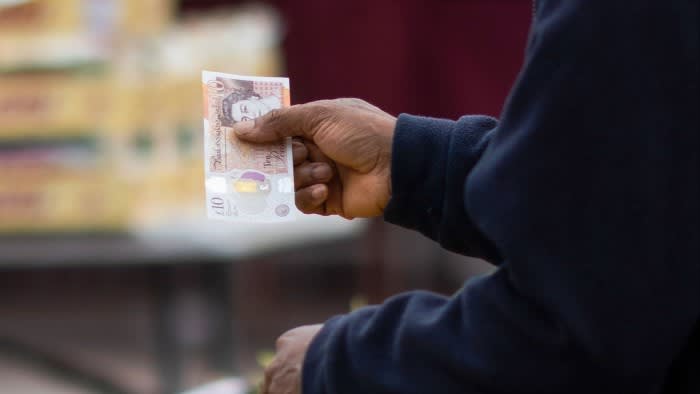Unlock the Editor’s Digest for free
Roula Khalaf, Editor of the FT, selects her favourite stories in this weekly newsletter.
Sterling is the only major developed world currency to strengthen against the dollar this year, driven by a stronger than expected UK economy and growing hopes of imminent US interest rate cuts.
The pound climbed 0.6 per cent to a seven-month high of $1.2893 against the US currency on Friday, after a large downgrade to January’s blockbuster US jobs data raised expectations that the Federal Reserve will begin cutting rates by June.
The move takes sterling’s gains to 1.2 per cent against the greenback so far this year. The rest of the G10 group of heavily traded currencies are down against the dollar, with the euro losing 0.7 per cent, the Canadian dollar down 1.5 per cent and the Japanese yen sliding 4 per cent.
Support for sterling comes as traders shift to price in two or three 0.25 percentage point interest rate cuts from the Bank of England this year, compared with six quarter-point cuts that were priced in at the start of the year.
A relatively stable political backdrop — with a general election later this year unlikely to upend economic orthodoxy — has also helped, analysts say.
“Suddenly the UK looks more boring compared to other countries — and boring is good,” said Athanasios Vamvakidis, global head of G10 FX strategy at Bank of America. “It means you avoid volatility.”
Vamvakidis added that no matter who wins the looming election, “we are going to get mainstream politics”. In contrast, investors face “a major uncertainty” in the form of November’s US presidential election and “extreme rightwing parties rising in the polls” in Europe, he said.
Although the UK economy sank into a technical recession at the end of last year, investors have been encouraged by recent upbeat business surveys that suggest the downturn will be shortlived.
The S&P purchasing manager’s index, a measure of activity in the private sector, rose to 53.3 in February, up from 52.9 in January and the highest since May 2023. A reading above 50 indicates expansion. House prices also rose compared with 12 months earlier for the first time in more than a year last month, according to figures published earlier this month by Nationwide.
Sterling’s strength “reflects a ‘not as bad as expected’ economic performance for the UK last year and hopes that growth in 2024 may be a little better”, said Jane Foley, senior FX strategist at Rabobank.
A return to “relatively dull UK politics” under Prime Minister Rishi Sunak, compared with his predecessors Boris Johnson and Liz Truss, had helped restore confidence, she added.
Despite its recent gains, the pound remains well short of its post-pandemic high of $1.42 struck in June 2021.
Currency speculators including hedge funds have since the start of the year more than tripled the size of their bets on further gains for sterling against the dollar, according to the most recent data from the US Commodity Futures Trading Commission. The size of this “long” position tracked by the CFTC is now close to the nine-year high reached last summer.
Asset managers have also turned more optimistic. Michael Metcalfe, head of macro strategy at State Street, custodian to about $40tn of assets, said his firm’s data showed investors had “rapidly reassessed” their underweight positions in sterling since the beginning of the year. Investors are now positioned “close to neutral”, after expectations of rate cuts were scaled back by more in the UK than in the US or eurozone.
“Sterling’s resilience is mainly a story of carry [investors looking for higher-yielding assets] holding up and while the UK slipped into a technical recession last year, the recent leading economic indicators have been pretty positive,” said Kyle Chapman, an analyst at currency brokerage Ballinger & Co.
This week the Office for Budget Responsibility, the government’s spending watchdog, also painted a slightly brighter picture for the UK’s prospects in its forecasts, estimating that the economy will grow 0.8 per cent this year, up from a previous forecast of 0.7 per cent in November.
Real GDP per capita, which has steadily declined since early 2022, is expected to start recovering later this year and regain its pre-pandemic level in 2025.

